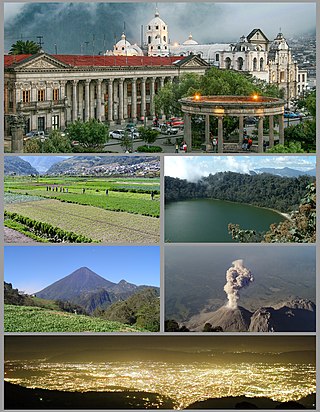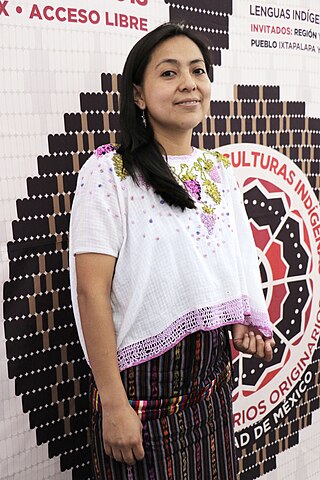Related Research Articles

Qʼuqʼumatz was a god of wind and rain of the Postclassic Kʼicheʼ Maya. It was the Feathered Serpent that according to the Popol Vuh created the world and humanity, together with the god Tepeu. It carried the sun across the sky and down into the underworld and acted as a mediator between the various powers in the Maya cosmos. It is considered to be the equivalent of the Aztec god Quetzalcoatl and of Kukulkan, of the Yucatec Maya.

Popol Vuh is a text recounting the mythology and history of the Kʼicheʼ people of Guatemala, one of the Maya peoples who also inhabit the Mexican states of Chiapas, Campeche, Yucatan and Quintana Roo, as well as areas of Belize, Honduras and El Salvador.

The Mayan languages form a language family spoken in Mesoamerica, both in the south of Mexico and northern Central America. Mayan languages are spoken by at least six million Maya people, primarily in Guatemala, Mexico, Belize, El Salvador and Honduras. In 1996, Guatemala formally recognized 21 Mayan languages by name, and Mexico recognizes eight within its territory.
Kʼicheʼ are Indigenous peoples of the Americas and are one of the Maya peoples. The eponymous Kʼicheʼ language is a Mesoamerican language in the Mayan language family. The highland Kʼicheʼ states in the pre-Columbian era are associated with the ancient Maya civilization, and reached the peak of their power and influence during the Mayan Postclassic period.

Tecun Uman was one of the last rulers of the K'iche' Maya people, in the Highlands of what is now Guatemala. According to the Kaqchikel annals, he was slain by Spanish conquistador Pedro de Alvarado while waging battle against the Spanish and their allies on the approach to Quetzaltenango on 12 February 1524. Tecun Uman was declared Guatemala's official national hero on March 22, 1960, and is commemorated on February 20, the popular anniversary of his death. Tecun Uman has inspired a wide variety of activities ranging from the production of statues and poetry to the retelling of the legend in the form of folkloric dances to prayers. Despite this, Tecun Uman's existence is not well documented, and it has proven to be difficult to separate the man from the legend.

The Maya are an ethnolinguistic group of indigenous peoples of Mesoamerica. The ancient Maya civilization was formed by members of this group, and today's Maya are generally descended from people who lived within that historical region. Today they inhabit southern Mexico, Guatemala, Belize, and westernmost El Salvador and Honduras.

Quetzaltenango is a department in the western highlands of Guatemala. The capital is the city of Quetzaltenango, the second largest city in Guatemala. The department is divided up into 24 municipalities. The inhabitants include Spanish-speaking Ladinos and the Kʼicheʼ and Mam Maya groups, both with their own Maya language. The department consists of mountainous terrain, with its principal river being the Samalá River. the department is seismically active, suffering from both earthquakes and volcanic activity.
Xquic is a mythological figure known from the 16th century Kʼicheʼ manuscript Popol Vuh. She was the daughter of one of the lords of Xibalba, called Cuchumaquic, Xibalba being the Maya underworld. Noted particularly for being the mother of the Maya Hero Twins, Hunahpu and Xbalanque, she is sometimes considered to be the Maya goddess associated with the waning moon. However, there is no evidence for this in the Popol Vuh text itself.
Cubulco is a small town, with a population of 10,681, located in the Guatemalan department of Baja Verapaz, at 15°6′30″N90°37′50″W. It serves as the administrative seat for the surrounding municipality of the same name. The municipality covers an area of 711 km² and has a population of 54,869 (2018).

Ixil (Ixhil) is a Mayan language spoken in Mexico and Guatemala. It is the primary language of the Ixil people, which mainly comprises the three towns of San Juan Cotzal, Santa Maria Nebaj, and San Gaspar Chajul in the Guatemalan highlands and numerous towns in the states of Campeche and Quintana Roo in southeast México. There is also an Ixil speaking migrant population in Guatemala City, Mexico City and the United States. Although there are slight differences in vocabulary in the dialects spoken by people in the three main guatemalan Ixil towns, they are all mutually intelligible and should be considered dialects of a single language. According to historical linguistic studies Ixil emerged as a separate language sometime around the year 500AD.

General elections were held in Guatemala on 9 September to elect a new President and Vice President of the Republic, 158 congressional deputies, and 332 mayors. As no presidential candidate received a majority of the vote, a second round was held on 4 November.

Humberto Akʼabal, also Akʼabʼal or Akabal, was a Kʼicheʼ Maya poet from Guatemala. Akʼabʼal wrote in his native language of Kʼicheʼ, and then translated his poetry into Spanish. With the translations of his works into numerous languages and international recognition, Akʼabʼal is considered to be "the most renowned Maya Kiʼcheʼ poet" in the world and one of the best known Guatemalan writers in Europe and Latin America.
The Baile de la Conquista or Dance of the Conquest is a traditional folkloric dance from Guatemala. The dance reenacts the invasion led by Spanish conquistador Pedro de Alvarado and his confrontation with Tecun Uman, ruler of K'iche' kingdom of Q'umarkaj. Although the dance is more closely associated with Guatemalan traditions, it has been performed in early colonial regions of Latin America at the urging of Catholic friars and priests, as a method of converting various native populations and African slaves to the Catholic Church.
Cuatro Balam is an initiative by the government of Guatemala to dramatically increase tourism in the Maya Biosphere Reserve, focusing on the region's numerous archeological sites. The Reserve is a protected area of 21,602 km2 in Guatemala's northernmost Petén Department. The Reserve contains national parks and wildlife preserves, and "multiple use" zones where limited human settlement and activity are permitted.

Chojolom is a small Maya archaeological site in the western highlands of Guatemala. The site features a number of sculpted stones that are presumed to belong to the Kʼicheʼ Maya culture of the Postclassic Period. Chojolom is situated on a hill in the municipality of Cantel, in the department of Quetzaltenango. The municipality is inhabited by Kʼicheʼ Maya to this day, who make up 93.8% of the local population. Cantel is located 10 kilometres (6.2 mi) from the modern city of Quetzaltenango at Kilometer 217 on the CA2 Highway. Chojolom is believed to have been a ritual site.

Kʼicheʼ, or Quiché, is a Mayan language spoken by the Kʼicheʼ people of the central highlands in Guatemala and Mexico. With over a million speakers, Kʼicheʼ is the second most widely-spoken language in the country, after Spanish. It is one of the most widely-spoken indigenous American languages in Mesoamerica.
Nicolás Suazo Velásquez is a retired Honduran footballer who played as a forward.

Cerro Quiac is a small Maya archaeological site located at an altitude of 2,635 metres (8,645 ft), overlooking the Plains of Urbina in the Guatemalan Highlands. When investigated in 1970 it had five stone sculptures, by 1977 only four were left. The sculptures included figures and geometric decoration. The site is still used for contemporary Maya rituals. Cerro Quiac is located in the northeast of the municipality of Cantel, within the boundaries of the hamlet of Chirijquiac.

María Jacinta X. Riquiac is a Maya Kʼicheʼ anthropologist and indigenous rights activist from Guatemala.

Manuela Alvarado López is a Guatemalan indigenous activist and politician. A founding member of Semilla party, she is member of the Central American Parliament for Guatemala since 2024, having been elected in 2023 general election.
References
- ↑ "Luis Enrique Sam Colop, 1955-2011 | American Indian Studies". Ais.arizona.edu. Retrieved 2011-12-19.
- ↑ William D. Davies and Luis Enrique Sam-Colop, K‘iché and the structure of antipassive, Language 66, 522-549. (1990)
- ↑ Prensa Libre (newspaper), Guatemala.
- ↑ Nick Copeland Cruel Populism: Counterinsurgency Strategy and the Limits of Democracy in the Guatemalan Highlands Archived 2010-06-10 at the Wayback Machine , pages 10 and 29. LASC Working Paper N.21, University of Maryland
- ↑ Alberto M. Fernández, Review of Kay B. Warren's Pan-Maya Activism in Guatemala Archived 2010-07-06 at the Wayback Machine . ReVista online journal, Harvard (Spring 1999).
- ↑ Franz Galich, ¿Existe una literatura indígena en Guatemala? Archived 2009-03-23 at the Wayback Machine . Accessed March 08, 2009
- ↑ Luis Enrique Sam Colop, Maya Poetics. Ph.D. dissertation, SUNY at Buffalo. University Microfilms, Ann Arbor (1994)
- ↑ Building Student Exchanges with the Emerging Democratic World Archived 2010-05-30 at the Wayback Machine . Grant proposal, St. Mary's College of Maryland (2003).
- ↑ Luis Enrique Sam-Colop, Versos sin refugio (1980). 32 pages, in Spanish.
- ↑ Luis Enrique Sam-Colop, La copa y la raíz. Editorial San Antonio, Guatemala (1979). In Spanish and K‘iche‘.
- ↑ Luis Enrique Sam-Colop, Jub'aqtun Omay Kuchum K'aslemal, Cinco siglos de encumbrimento. Series Seminario Permanente de Estudios Mayas, No. 1. Cholsamaj, Guatemala (1991). 42 pages, in Spanish.
- ↑ Luis Enrique Sam Colop, Popol Wuj — Versión Poética K‘iche‘. PEMBI/GTZ/Cholsamaj, Guatemala (1999). In the Quiché Maya language.